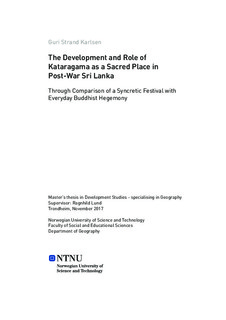The Development and role of Kataragama as a sacred place in post-war Sri Lanka : through comparison of a Syncretic Festival with everyday Buddhist hegemony
Master thesis
Permanent lenke
http://hdl.handle.net/11250/2506113Utgivelsesdato
2017Metadata
Vis full innførselSamlinger
- Institutt for geografi [1097]
Sammendrag
The religious complex of Kataragama located in southeast Sri Lanka is explored as a place from a cultural-geography perspective in this thesis. It was chosen due to the multicultural attributes it has through the veneration of devotees with Hindu, Buddhist, Muslim, Christian and Vädda identities. By focusing on the intersection between place and religion through sacred geography and scales the various cultural traces that affect the place and its development are assessed and place is considered as a process. Qualitative methodology has been used in order to explore the private domain of religion; through observation and semistructured interviews that allowed flexibility. The case study of the multicultural Kataragama festival in August is at the core of this analysis, yet it is compared to the off-season as well as the place is visited by more diverse groups during the festival than otherwise, and it is argued through the empirical and intersubjective data from religious representatives and secondary data, that this is important due to the various claims to the different sacred places. The Kataragama Maha Devale is the focus of the claims and it has also been affected by the Buddhicization processes that the entire country shows evidence of through the investments in Buddhist heritage over other minorities’. Yet this thesis also finds that while Kataragama has changed, and the Maha Devale especially as my Hindu informant felt out-of-place there, it is still an important and multicultural place namely due to the many devotees who celebrate religion together during the fifteen-day festival.
